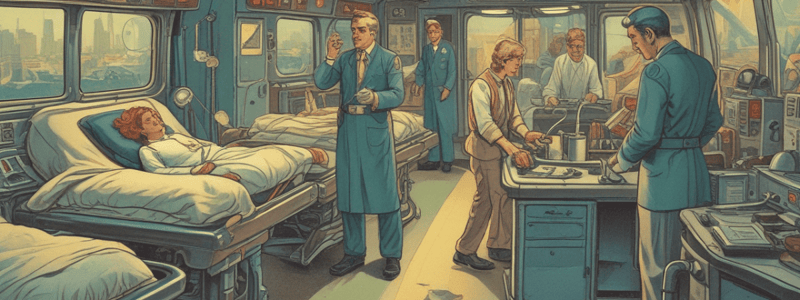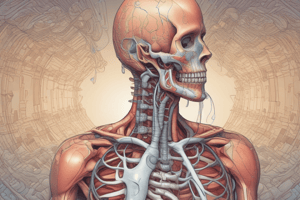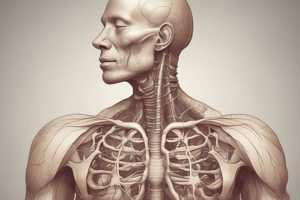Podcast
Questions and Answers
What is the primary function of positive end-expiratory pressure (PEEP)?
What is the primary function of positive end-expiratory pressure (PEEP)?
- To increase the volume of dead space in the respiratory system
- To increase intrathoracic pressure and improve gas exchange
- To prevent end-expiratory collapse of the small airways and alveoli (correct)
- To decrease the work of breathing during exhalation
What is the typical range of anatomical PEEP in healthy individuals?
What is the typical range of anatomical PEEP in healthy individuals?
- 3-5 cmH2O (correct)
- 5-7 cmH2O
- 1-3 cmH2O
- 7-9 cmH2O
What is the primary mechanism by which inhalation occurs during natural inspiration?
What is the primary mechanism by which inhalation occurs during natural inspiration?
- Passive elastic recoil of the lungs
- Active contraction of the intercostal muscles
- Positive pressure ventilation pushing air into the lungs
- Negative pressure ventilation sucking air into the lungs (correct)
What is the primary function of exhalation during normal breathing?
What is the primary function of exhalation during normal breathing?
What is the primary purpose of PEEP in patients with acute respiratory distress syndrome (ARDS)?
What is the primary purpose of PEEP in patients with acute respiratory distress syndrome (ARDS)?
What is the primary complication associated with the use of high levels of PEEP?
What is the primary complication associated with the use of high levels of PEEP?
What is the primary purpose of CPAP (continuous positive airway pressure) ventilation?
What is the primary purpose of CPAP (continuous positive airway pressure) ventilation?
What is the approximate percentage of each breath that is comprised of dead space in a healthy individual?
What is the approximate percentage of each breath that is comprised of dead space in a healthy individual?
What is the primary mechanism by which PEEP improves gas exchange in patients with acute respiratory distress syndrome (ARDS)?
What is the primary mechanism by which PEEP improves gas exchange in patients with acute respiratory distress syndrome (ARDS)?
What is the primary difference between natural inspiration and positive pressure ventilation in terms of the mechanics of air movement?
What is the primary difference between natural inspiration and positive pressure ventilation in terms of the mechanics of air movement?
What is the primary mechanism by which carbon dioxide (CO2) is eliminated from the body during respiration?
What is the primary mechanism by which carbon dioxide (CO2) is eliminated from the body during respiration?
What is the primary consequence of a complete cessation of ventilation?
What is the primary consequence of a complete cessation of ventilation?
Which of the following conditions is primarily responsible for the mismatch between arterial and end-tidal carbon dioxide levels (PaCO2 and ETCO2)?
Which of the following conditions is primarily responsible for the mismatch between arterial and end-tidal carbon dioxide levels (PaCO2 and ETCO2)?
What is the primary stimulus for breathing in normal physiology?
What is the primary stimulus for breathing in normal physiology?
What is the primary benefit of pre-oxygenation and passive oxygenation in patients with respiratory distress?
What is the primary benefit of pre-oxygenation and passive oxygenation in patients with respiratory distress?
What is the primary consequence of excessive ventilation in a patient with normal lung function?
What is the primary consequence of excessive ventilation in a patient with normal lung function?
What is the primary factor that determines the efficiency of ventilation in patients with lung disease?
What is the primary factor that determines the efficiency of ventilation in patients with lung disease?
What is the primary mechanism by which positive end-expiratory pressure (PEEP) improves gas exchange in patients with acute respiratory distress syndrome (ARDS)?
What is the primary mechanism by which positive end-expiratory pressure (PEEP) improves gas exchange in patients with acute respiratory distress syndrome (ARDS)?
What is the primary consequence of an increase in the arterial partial pressure of carbon dioxide (PaCO2) in patients with chronic obstructive pulmonary disease (COPD)?
What is the primary consequence of an increase in the arterial partial pressure of carbon dioxide (PaCO2) in patients with chronic obstructive pulmonary disease (COPD)?
What is the primary mechanism by which the body maintains the partial pressure gradient for carbon dioxide (CO2) elimination during respiration?
What is the primary mechanism by which the body maintains the partial pressure gradient for carbon dioxide (CO2) elimination during respiration?
What is the best way to manage BVM ventilations according to the text?
What is the best way to manage BVM ventilations according to the text?
What is the optimal position for intubating non-traumatic adult patients?
What is the optimal position for intubating non-traumatic adult patients?
Which position is recommended for children and pediatric patients during intubation?
Which position is recommended for children and pediatric patients during intubation?
What should be avoided when managing an airway using a BVM?
What should be avoided when managing an airway using a BVM?
What is the traditional method of utilizing the BVM?
What is the traditional method of utilizing the BVM?
What can optimize patient oxygenation prior to intubation?
What can optimize patient oxygenation prior to intubation?
What is the primary purpose of the 'Jaw Thrust' technique in airway management?
What is the primary purpose of the 'Jaw Thrust' technique in airway management?
What is the significance of the '4-90's' mentioned in the text?
What is the significance of the '4-90's' mentioned in the text?
What is the primary purpose of the 'Mallampati' assessment mentioned in the text?
What is the primary purpose of the 'Mallampati' assessment mentioned in the text?
What is the primary purpose of the 'Scissor Technique' in airway management?
What is the primary purpose of the 'Scissor Technique' in airway management?
What is the primary goal of the 'System One Training' mentioned in the text?
What is the primary goal of the 'System One Training' mentioned in the text?
What is the significance of the '3:3:2' rule in airway assessment?
What is the significance of the '3:3:2' rule in airway assessment?
What is the primary purpose of the 'Head Tilt' technique mentioned in the text?
What is the primary purpose of the 'Head Tilt' technique mentioned in the text?
What is the significance of the term 'Airway is a team sport' mentioned in the text?
What is the significance of the term 'Airway is a team sport' mentioned in the text?
What is the primary indication for using a bougie during a difficult adult intubation?
What is the primary indication for using a bougie during a difficult adult intubation?
Which of the following is NOT a primary function of positive end-expiratory pressure (PEEP) in patients with acute respiratory distress syndrome (ARDS)?
Which of the following is NOT a primary function of positive end-expiratory pressure (PEEP) in patients with acute respiratory distress syndrome (ARDS)?
What is the primary purpose of the tongue traction technique described in the text?
What is the primary purpose of the tongue traction technique described in the text?
Which of the following is the primary mechanism by which positive end-expiratory pressure (PEEP) improves gas exchange in patients with acute respiratory distress syndrome (ARDS)?
Which of the following is the primary mechanism by which positive end-expiratory pressure (PEEP) improves gas exchange in patients with acute respiratory distress syndrome (ARDS)?
What is the primary purpose of the 'C-DOPE' mnemonic when questioning endotracheal tube (ETT) placement?
What is the primary purpose of the 'C-DOPE' mnemonic when questioning endotracheal tube (ETT) placement?
What is the primary consequence of a complete cessation of ventilation in a healthy individual?
What is the primary consequence of a complete cessation of ventilation in a healthy individual?
What is the primary purpose of the 'Modified Cormack & Lehane Classification' mentioned in the text?
What is the primary purpose of the 'Modified Cormack & Lehane Classification' mentioned in the text?
What is the primary stimulus for breathing in normal physiology?
What is the primary stimulus for breathing in normal physiology?
What is the primary purpose of the 'King Airway' device?
What is the primary purpose of the 'King Airway' device?
What is the primary function of exhalation during normal breathing?
What is the primary function of exhalation during normal breathing?
What is the primary mechanism by which positive end-expiratory pressure (PEEP) improves gas exchange in patients with acute respiratory distress syndrome (ARDS)?
What is the primary mechanism by which positive end-expiratory pressure (PEEP) improves gas exchange in patients with acute respiratory distress syndrome (ARDS)?
What is the primary mechanism by which the body maintains the partial pressure gradient for carbon dioxide (CO2) elimination during respiration?
What is the primary mechanism by which the body maintains the partial pressure gradient for carbon dioxide (CO2) elimination during respiration?
What is the primary consequence of an increase in the arterial partial pressure of carbon dioxide (PaCO2) in patients with chronic obstructive pulmonary disease (COPD)?
What is the primary consequence of an increase in the arterial partial pressure of carbon dioxide (PaCO2) in patients with chronic obstructive pulmonary disease (COPD)?
What is the primary purpose of the 'System One Training' mentioned in the text?
What is the primary purpose of the 'System One Training' mentioned in the text?
Which of the following is the primary mechanism by which carbon dioxide (CO2) is eliminated from the body during respiration?
Which of the following is the primary mechanism by which carbon dioxide (CO2) is eliminated from the body during respiration?
Which of the following conditions is primarily responsible for the mismatch between arterial and end-tidal carbon dioxide levels (PaCO2 and ETCO2)?
Which of the following conditions is primarily responsible for the mismatch between arterial and end-tidal carbon dioxide levels (PaCO2 and ETCO2)?
What is the primary stimulus for breathing in normal physiology?
What is the primary stimulus for breathing in normal physiology?
What is the primary mechanism by which positive end-expiratory pressure (PEEP) improves gas exchange in patients with acute respiratory distress syndrome (ARDS)?
What is the primary mechanism by which positive end-expiratory pressure (PEEP) improves gas exchange in patients with acute respiratory distress syndrome (ARDS)?
What is the primary difference between natural inspiration and positive pressure ventilation in terms of the mechanics of air movement?
What is the primary difference between natural inspiration and positive pressure ventilation in terms of the mechanics of air movement?
What is the primary consequence of a complete cessation of ventilation?
What is the primary consequence of a complete cessation of ventilation?
What is the primary function of exhalation during normal breathing?
What is the primary function of exhalation during normal breathing?
What is the primary mechanism by which inhalation occurs during natural inspiration?
What is the primary mechanism by which inhalation occurs during natural inspiration?
What is the primary consequence of excessive ventilation in a patient with normal lung function?
What is the primary consequence of excessive ventilation in a patient with normal lung function?
What is the primary purpose of the 'S.A.L.A.D.' technique?
What is the primary purpose of the 'S.A.L.A.D.' technique?
Which technique involves applying backward, upward, and rightward pressure to improve visualization of the larynx during intubation?
Which technique involves applying backward, upward, and rightward pressure to improve visualization of the larynx during intubation?
What is the primary purpose of using a bougie during a difficult intubation?
What is the primary purpose of using a bougie during a difficult intubation?
Which technique involves applying external pressure on the cricoid cartilage to improve visualization of the larynx?
Which technique involves applying external pressure on the cricoid cartilage to improve visualization of the larynx?
What is the purpose of using different blade grips during intubation?
What is the purpose of using different blade grips during intubation?
Which technique involves applying traction on the patient's lips to improve visualization of the larynx?
Which technique involves applying traction on the patient's lips to improve visualization of the larynx?
What is the purpose of inflating the balloon on the endotracheal tube during intubation?
What is the purpose of inflating the balloon on the endotracheal tube during intubation?
Flashcards are hidden until you start studying
Study Notes
Respiratory Physiology and Mechanics
- The primary function of positive end-expiratory pressure (PEEP) is to improve oxygenation and increase functional residual capacity.
- Anatomical PEEP in healthy individuals ranges from 0.5-1.5 cmH2O.
Inspiration and Exhalation
- Inspiration occurs during natural inspiration through the diaphragm and intercostal muscles, which increase thoracic volume and decrease intrathoracic pressure.
- Exhalation during normal breathing serves to remove carbon dioxide from the lungs.
PEEP in ARDS
- PEEP in patients with acute respiratory distress syndrome (ARDS) aims to improve oxygenation, reduce shunt fraction, and optimize lung compliance.
Complications of PEEP
- The primary complication associated with high levels of PEEP is decreased cardiac output due to increased intrathoracic pressure.
CPAP Ventilation
- The primary purpose of CPAP (continuous positive airway pressure) ventilation is to improve oxygenation, reduce the work of breathing, and prevent atelectasis.
Dead Space Ventilation
- In healthy individuals, approximately 30% of each breath is comprised of dead space.
Gas Exchange in ARDS
- PEEP improves gas exchange in ARDS patients by increasing functional residual capacity, reducing shunt fraction, and optimizing lung compliance.
Natural Inspiration vs. Positive Pressure Ventilation
- The primary difference between natural inspiration and positive pressure ventilation is the direction of air movement, with natural inspiration involving diaphragmatic contraction and positive pressure ventilation involving external pressure.
Carbon Dioxide Elimination
- The primary mechanism by which carbon dioxide (CO2) is eliminated from the body during respiration is through exhalation.
Consequences of Cessation of Ventilation
- Complete cessation of ventilation leads to asphyxia and eventual death.
Mismatch between Arterial and End-Tidal Carbon Dioxide Levels
- The primary condition responsible for the mismatch between arterial and end-tidal carbon dioxide levels (PaCO2 and ETCO2) is ventilation-perfusion mismatch.
Stimulus for Breathing
- The primary stimulus for breathing in normal physiology is the partial pressure of carbon dioxide (PaCO2) in the arterial blood.
Pre-Oxygenation and Passive Oxygenation
- Pre-oxygenation and passive oxygenation in patients with respiratory distress aim to increase oxygen reserves and reduce the risk of hypoxia.
Excessive Ventilation
- The primary consequence of excessive ventilation in a patient with normal lung function is respiratory alkalosis.
Ventilation in Lung Disease
- The primary factor that determines the efficiency of ventilation in patients with lung disease is the degree of ventilation-perfusion mismatch.
PEEP in ARDS
- PEEP improves gas exchange in ARDS patients by increasing functional residual capacity, reducing shunt fraction, and optimizing lung compliance.
Consequences of Increased PaCO2 in COPD
- An increase in the arterial partial pressure of carbon dioxide (PaCO2) in patients with chronic obstructive pulmonary disease (COPD) leads to respiratory acidosis.
Carbon Dioxide Elimination
- The primary mechanism by which the body maintains the partial pressure gradient for carbon dioxide (CO2) elimination during respiration is through the ventilation-perfusion ratio.
Airway Management and Intubation
- The optimal position for intubating non-traumatic adult patients is the sniffing position.
- The primary purpose of the 'Jaw Thrust' technique in airway management is to improve visualization of the larynx.
- The 'Mallampati' assessment is used to predict difficulty in intubation.
- The 'Scissor Technique' is used to optimize laryngeal view during intubation.
- The 'Head Tilt' technique is used to improve airway patency.
- The '3:3:2' rule is used to assess airway difficulty.
- The primary indication for using a bougie during a difficult adult intubation is to improve visualization of the larynx.
Note: The rest of the questions are mostly repetitive or similar in context, so I didn't include them in the summary.
Studying That Suits You
Use AI to generate personalized quizzes and flashcards to suit your learning preferences.



